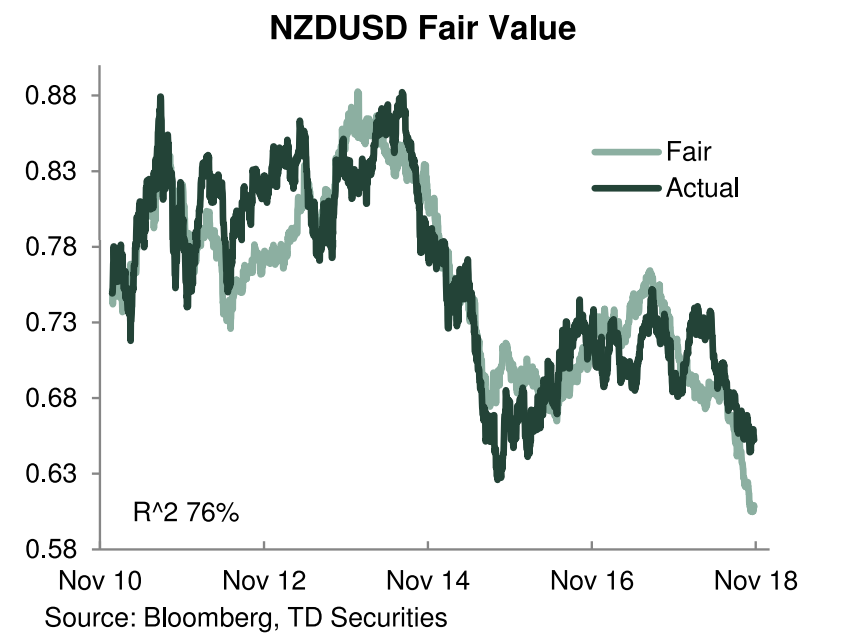The Kiwi Economy is Just Fine but the New Zealand Dollar Won't Know it For a While Yet
- Written by: James Skinner
-

Image © Adobe Stock
- NZD/USD rate eyes potential 12% loss for 2018 year.
- The economy is fine but NZD won't know it until 2019.
- Interest rate dynamics to force NZD lower in meantime.
The Kiwi economy is doing much better than the market gives credit for but the New Zealand Dollar is unlikely to discover this until some time early in the 2019 year, according one analyst.
In the meantime, the Kiwi currency is set to continue its decline as the global interest rate tables turn further against the New Zealand Dollar, taking its 2018 loss across the 10% threshold.
"The economy is in good shape, with numerous price and activity data reports surprising to the upside since the Aug monetary policy statement (MPS). The Nov MPS needs to reflect 2019 GDP and CPI upgrades at a minimum, as well as acknowledge the weaker exchange rate," says Annette Beacher, chief Asia Pacific macro strategist at TD Securities.
New Zealand's Dollar has been blighted by a duo of headwinds in 2018, beginning with disappointing inflation and growth data that has driven a deterioration of the Kiwi interest rate outlook, and more recently an escalation of the so called trade war between the U.S. and China.
The inflation and growth outlook has been become so tepid the Reserve Bank of New Zealand (RBNZ) begun warning in July that it could cut interest rates over coming quarters if the economy does not pick up sufficiently to support a return of the consumer price index toward the upper end of the 1% to 3% target band.
Coming amid President Donald Trump's trade war with New Zealand's largest customer for its chief exports of agricultural goods, China, speculators have bet heavily against the Kiwi Dollar in 2018. So much so that the amount of money now stacked against the Kiwi is close to a record high.
"However, our simple fair value model says NZD is rich and we cannot rule out the RBNZ Governor reviving rate cut talk at the 8 Nov MPS, keeping overnight-index-swaps and NZD under pressure," warns Beacher.

Above: TD Securities: NZD/USD (dark green) and estimated 'fair value' (light green).
Beacher says it will be early in the 2019 year until the GDP and inflation data covering the second half of 2018 is all released. So it will be some time before official data reveals that the foreign exchange market has become too bearish in its outlook for the Kiwi Dollar.
New Zealand's inflation rate has been below the midpoint of the 1% to 3% target band for most of the time since 2012, necessitating a "loose" monetary policy from the RBNZ. The central bank has now kept its interest rate at a record low of 1.75% for almost two years.
Rates have been kept at ultra low levels in New Zealand despite that other central banks have been raising their benchmarks for some time now, creating an incentive for international investors to shun the Kiwi and buy other assets such as U.S. bonds instead.
This has already seen the NZD/USD rate decline 7.8% so far in 2018 but one other strategist suggested on Friday that it could fall even further still during the months ahead, taking the currency pair's full year loss to nearly 12%.
"With NZD/USD having broken the 0.65 level, and very few positive catalysts on the horizon, there’s a risk that we could see a decline to 0.61-0.62 (2015 lows) on the back of rising US Treasury yields in the coming months. For now, we think NZD/USD will spend most of its time below 0.65 in 4Q18 - with investors retaining a sell on rallies bias," says Viraj Patel, an FX strategist at ING Group.
Pound-to-New-Zealand-Dollar rate has risen just 3.69% in 2018 due to ongoing uncertainty about the U.K.'s future relationship with the European Union. It was quoted 0.18% higher at 1.9678 Friday.
However, if the NZD/USD rate undergoes another steep decline then assuming the GBP/USD rate avoids a similar fate, the Pound-to-Kiwi rate will be able to rise.
The Pound-to-Kiwi rate is after all a foreign exchange cross rate that is calculated at its most basic level by dividing the Pound-Dollar rate over the NZD/USD rate.
In order for the Sterling to rise against the Kiwi, the Pound must move further and faster against the Dollar than its Antipodean counterpart does - or fall more slowly against the Dollar than its Kiwi counterpart.
Advertisement
Bank-beating exchange rates! Get up to 5% more foreign exchange by using a specialist provider to get closer to the real market rate and avoid the gaping spreads charged by your bank when providing currency. Learn more here





